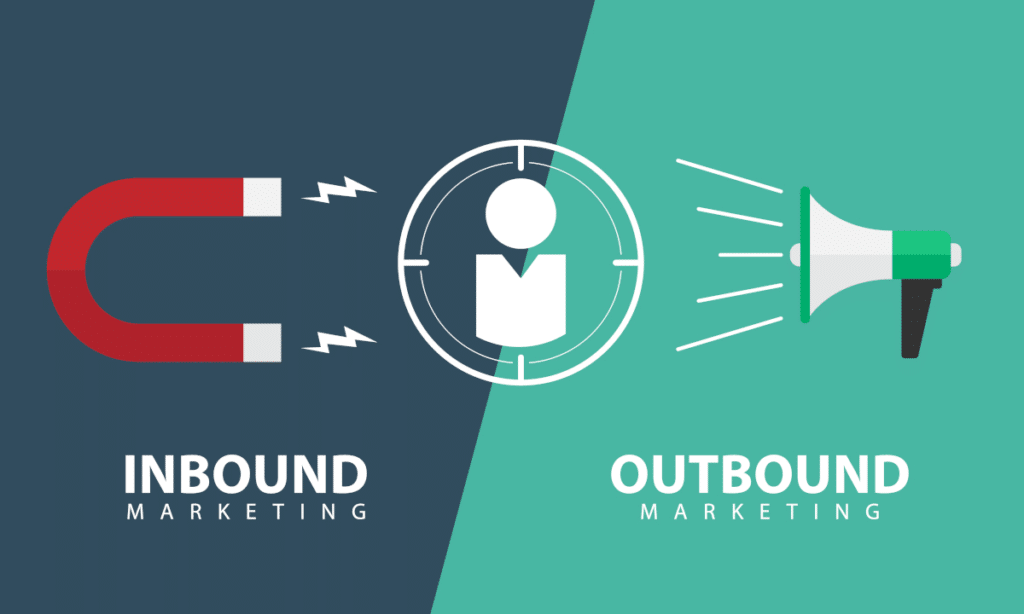Inbound Marketing is a marketing technique that is focused on attracting customers to your business. It focuses on creating content that will attract the attention of potential customers and convert them into leads.
Outbound Marketing is a marketing technique that is focused on getting the attention of potential customers through advertising and direct communication.
These two terms are often used interchangeably, but they are not the same thing. Inbound Marketing attracts people to your business, while Outbound Marketing attracts people to your business by reaching out to them.

Inbound Marketing
When companies engage interested customers using sales representatives, this is known as inbound marketing. Customers’ desire is the focal point of inbound marketing. In a sense, they act as a trusted mentor, guiding them through the buying journey by adapting their methods to meet the buyer’s needs.
As every client and product they would like to buy is different, every inbound sale is different. Every purchase is a unique sales journey, as potential buyers will have different questions and different levels of interest. When identifying the journey a customer takes, an inbound sales process can offer support to the customer at every step.
Outbound Marketing
During outbound sales, businesses use their sales pitch or message to target unaware customers in an effort to gain their attention, engage them, and ultimately qualify them for sales. Rather than waiting for leads to come to them, cold calling, email marketing, social selling, and other forms of contact are often used in the outbound sales process.
Many people consider outbound marketing intrusive and dismiss it as a result. More and more customers are taking control of and initiating the sales cycle for themselves online as a result of a cultural shift towards inbound marketing. It can still be an effective approach when situations require highly targeted outreach, personal contact, immediate feedback, or a controlled pace.
Inbound and Outbound Marketing: Differences
Customers initiate contact with inbound marketing, and prospective customers are contacted by outbound marketing. If the customer seeks out the company or if the company seeks out the customer, that’s the first point of contact.
There is a difference in how customers and companies interact that may appear minor, but it represents a significant difference in business interactions. The inbound customer is usually more knowledgeable about the products and services they are looking for, is more engaged, and is more aware of the brand. At least at the beginning, outbound customers tend to be less engaged, less familiar with the brand and less informed about the products and services.
An examination of the stages of each might be helpful in understanding the differences between inbound and outbound marketing. The differences between them will also be revealed as their stages unfold.
Steps in Inbound Marketing
1. Generate content that is relevant
In turn, the company creates and posts its content to multiple channels to entice new customers. The posts can take the form of websites, blogs and articles. A company’s solutions, products and services can be promoted in this manner and attract the attention of the target audience. This could be a blog post answering customers’ biggest questions or a video that shows up in organic search when customers use popular keywords.

2. Make a call to action and provide guidance
The sales representative can assist a prospective customer looking into the product or service in more detail once the customer has engaged with the company. In this role, the sales rep acts as a mentor for the customer, helping him or her to identify challenges and provide solutions or tools. There is no hard-sell approach in this type of marketing.
Typically, at this point in the sales process, the sales representative makes a call to action, like setting up a demo or phone call or recommending to the customer that they purchase the product or service the sales agent has been presenting as a solution to the customer’s problem.
Steps in Outbound Marketing
[convertful id=”197361″]
1. Decide who your target audience is
Identifying prospective customers is the first step in outbound sales. In order to reach out to the people they want, companies create a list of potential customers. It is not unusual for sales representatives to use lists of customers with similar characteristics, for example, their demographics or location. Advertiser networks provide sales reps with prospects based on location or interest, allowing them to build lists of potential customers.
2. Make active efforts to attract new customers
Prospects are now contacted by sales representatives to determine if they are a good fit for the product or service. In addition to phone calls, advertisements and emails, they can also visit the offices in person. Ideally, a prospect will respond to a message or return a phone call in order to engage or respond. Prospective customers can begin the sales process when they move from unaware to responsive.
3. Make your pitch
An experienced sales rep can demonstrate a solution, a product or a service they’re selling at this point in the sales process. An effective pitch focuses on showing the prospective client what they’ll gain by buying the product or service, often by creating a vivid mental picture in or her head.
Conclusion: What is an inbound and outbound sales agent

An inbound sales agent is a person who engages customers by providing information about products and services, answering questions, and resolving customer problems. An outbound sales agent is a person who contacts prospects to offer information about products and services, answer questions, and resolve customer problems.
An inbound sales agent may work from an office or from home. They are often part of a team that includes other inbound agents, outbound sales agents, and other support staff such as administrative assistants or customer service representatives.
An outbound sales agent usually works from an office. They may work on a team that includes other outbound agents, inbound agents, and other support staff such as administrative assistants or customer service representatives.
Frequently Asked Questions
How do you increase inbound sales leads?
Inbound sales leads are a great way to build your business. It is important that you have a plan in place to increase these leads. Some of the best ways to increase inbound sales leads are:
– Building a strong content marketing strategy
– Creating lead magnets
– Building relationships with influencers
– Creating an email marketing strategy
How do you master outbound sales?
Mastering outbound sales are not easy. It requires a lot of time, energy and dedication. However, with the right tools and techniques in place, you can reach your desired outcome much quicker than you would have anticipated.
We’ve compiled a list of the top 10 best practices for mastering outbound sales to help you get started:
1) Define your target audience
2) Create an email campaign
3) Set up a tracking system
4) Leverage social media channels
5) Personalize your message
6) Use video to connect with prospects
7) Send targeted emails based on the prospect’s actions
8 ) Develop a strong value proposition
9 ) Create compelling content for your website or blog posts that will generate traffic and
What are inbound and outbound leads?
Inbound leads are leads that come to the company from the outside. These can include customers who come to a company website or call a company number looking for information or service.
Outbound leads are leads that are generated by the company and sent to prospects. These can include messages sent by email, phone, text message or social media posts.
The inbound lead process is a lot more passive than the outbound lead process because it relies on people coming to you instead of you going out and finding them. It is also cheaper because it doesn’t require any human resources, but it has a lower conversion rate than the outbound lead process, which requires human resources like salespeople and marketing staff.
Moreover, this process is also more predictable than the outbound lead process because every step of the inbound lead process has a known outcome. The inbound market is established, so there’s less risk involved.





